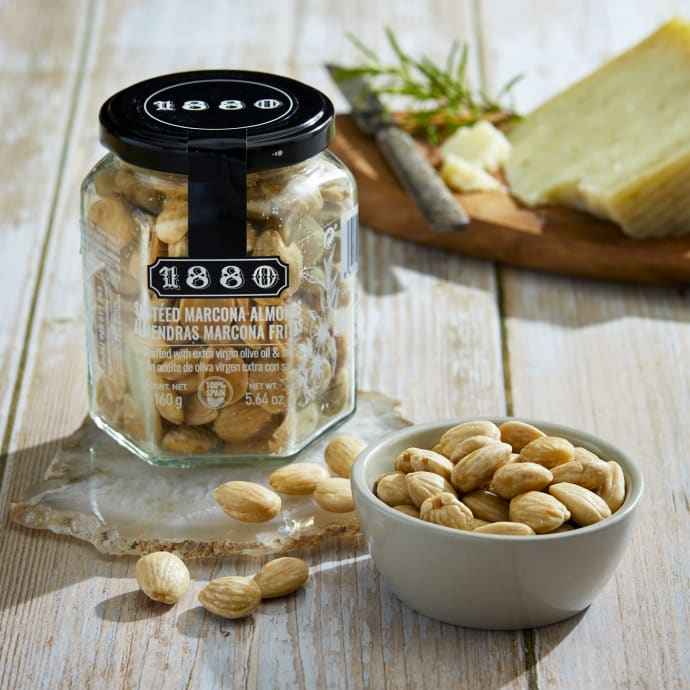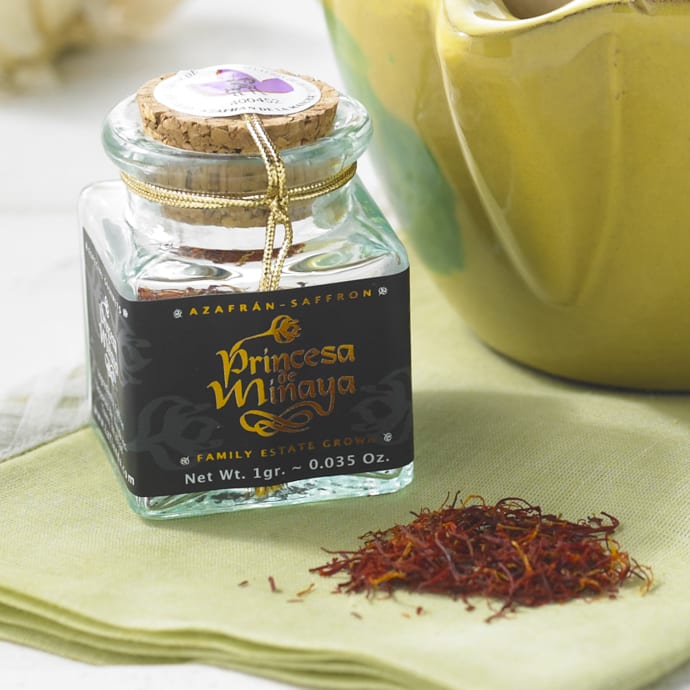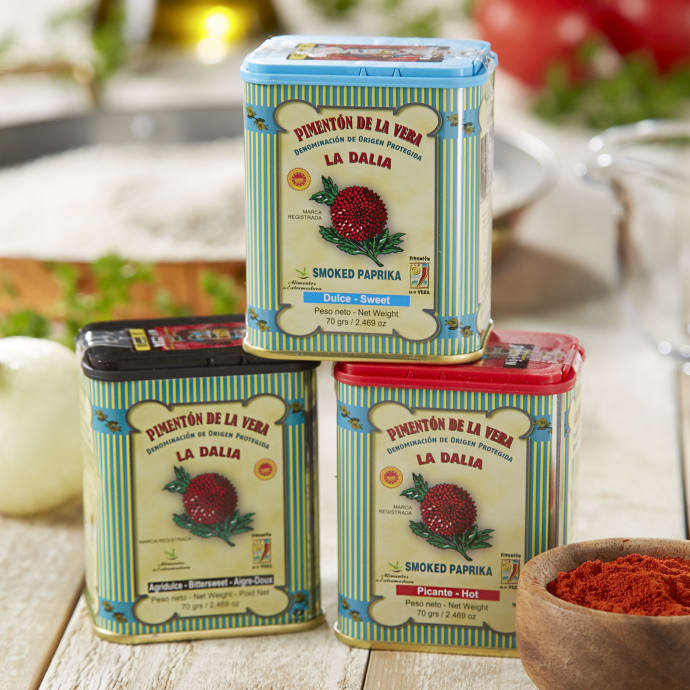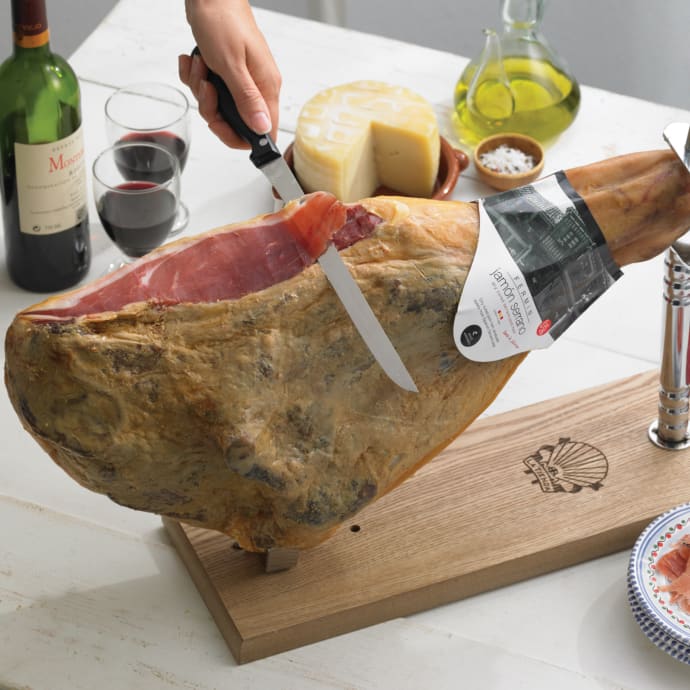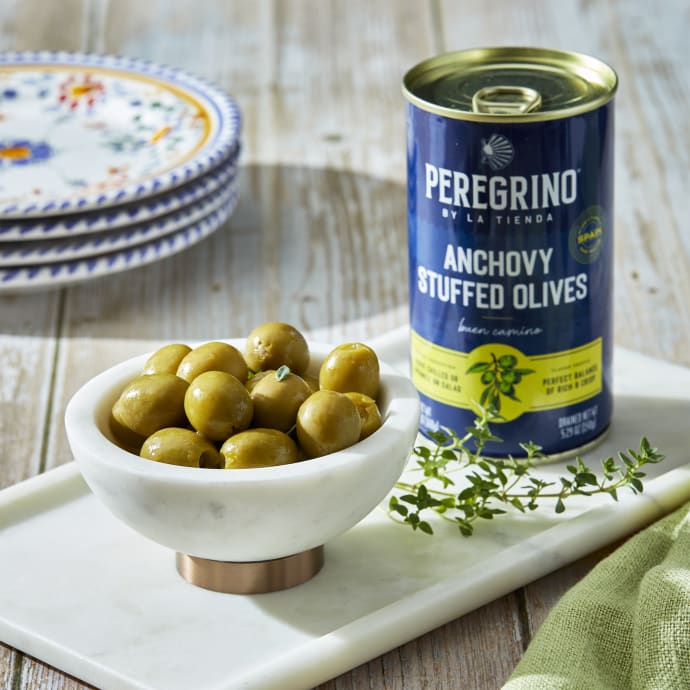
Entertaining With a Spanish Flair
Greenwich Magazine
-
October 1, 2007
Karen Berman
A gust of saffron and pimenton perfumes the air. But then, to the dismay of kitchen hoverers gathered around the hostess, she closes the oven door, deciding that the paella inside needs a few more minutes. Out in the living room, the host is wielding a treacherous-looking knife to produce paper-thin slices of jamon de serrano, the famed dry-cured country ham of Spain. Others are scooping up Marcona almonds and olives from pretty cazuelas. Some are sipping fino sherry, while others opt for a lovely Marques de Riscal white verdejo from Rueda. The music is low, the talk is convivial, and the clock seems to be moving in slow motion.
It feels like you've touched down in an apartment in Madrid's posh Salamanca district or a sunny villa on the Costa Brava. But no, this is your house, right here in Connecticut. It's just that you've cleverly transformed it, for one night only, into a corner bit of Spain.
Why Spain? Why now? Well, the food is delicious and quite doable for the home cook who is so inclined, the mood is fun and can be as casual as you like, and - perhaps most compelling for the trend-conscious party-giver - five-hundred-plus years after its first Golden Age, Spain is finally having its moment in the culinary sun.
Spanish food is like the actress who labors for years only to be declared an overnight sensation. It's been around forever, but for the food cognoscenti, it languished in the shadow of other ethnic cuisines, with periodic cameo appearances. In the 1970s, every steak house had its special recipe for sangria, Spain's refreshing wine and fruit quaff. In the 1980s and early '90s, the little dishes known as tapas came to the fore. Too often, though, Spanish food was mistaken for Mexican and vice versa.
It was a happy confluence of events in the 1990s that brought Spanish cuisine to our attention once again. The opening of the Frank Gehry-designed Guggenheim Museum in Bilbao had tourists from around the globe flocking to Spain. And in Catalunya, Chef Ferran Adria, stopped traffic -culinary traffic, that is - with his deconstructive cooking, most famously, his foams.
"People started hearing about Spanish food, about paella and tapas," says Don Harris, founder of tienda.com, a leading online merchant of Spanish food, wine, tableware and gifts. A retired navy chaplain, Harris spent years stationed in Spain and came to love the culture. On his retirement, he and his family began their online business. They now carry more than 600 products and are seeing sales growth of 30 to 40 percent each year, as clear an indicator as any of the rising interest in Spanish food and culture. It was in the late 1990s, he says, that "Spanish food broke into the American consciousness."
Spanish cooking is Mediterranean cooking, says Penelope Casas, who went to Spain as a college student, and, in a double stroke of fate, met her husband-to-be and found her calling as the foremost chronicler of Spanish food for the American cookbook audience. "There's a lot of emphasis on grains, beans, olive oil," she says. "Beef is not a big deal at all. Pork is much bigger, and Spaniards eat tons of seafood." The characteristic flavor profile of Spanish food, Casas adds, comes from a handful of ingredients: tomatoes, red peppers, olive oil, garlic and onion."
"A Spanish social gathering is all about the food," says Diana Lefer, an interior designer based in Fairfield. Lefer, whose father was born in Spain, knows that country well, as she has visited it at least once a year since she was a child, sometimes for months at a time, and she has close family there.
Spanish parties are "always built around the food, often around big-deal festive dishes like paella," agrees Gourmet's food columnist Colman Andrews, the former editor of Saveur and author of Catalan Cuisine: Europe's Last Great Culinary Secret.
"Most Spanish food is not super-elaborate," agrees Don Harris. Both he and Casas note that the lion's share of socializing and entertaining in Spain has traditionally taken place in tapas bars and restaurants.
"Today, however, there is more home entertaining and it's changed a lot," says Lefer. "It used to be very European in style. As with the French, you didn't entertain at home, except family." Those who did entertain at home did so with great formality. "When you went to a formal dinner at someone's home, you would never walk into the kitchen," she recalls. "There wasn't that loose, informal feeling."
"There's often an attractive casualness about Spanish parties," says Andrews. He cautions that entertaining styles in Spain depend on region, socio-economic level and age. But in general, he says, the mood is now relaxed. "It's pretty common for people to pitch in and help."
One thing is certain: When Spaniards do entertain, the food and drink are abundant, and the hospitality is boundless.
"When you visit a Spanish home," says Harris, "they'll sit you down and give you a glass of Manzanilla (sherry) and dishes of almonds or membrillo (quince jelly) and five, six or seven other dishes." Some tapas, in true tradition, will be simple, like the dishes of almonds, but for others, the host will turn to the stove and come up with something a bit more complex. "They might serve some garlic shrimp in a cazuela. You heat the olive oil and cook the shrimp with a little garlic," says Harris. "Very likely you'll be showered with a slew of different treats. Eating them will take hours."
A dinner party can be an equally prolonged affair. Your hosts will have set out a variety of nibbles on a table outdoors or on aside table in the dining room. Familiar tapas might include Cabrales, Spain's fabled blue cheese, or canned smoked mussels on toast rounds. You can visit the hosts in the kitchen as they prepare more elaborate dishes, then wander into the library or the garden, until they call you to the table.
Just don't expect that call to be too soon after your arrival. Andrews adds that parties tend to start later and last longer than they do here: "You'd invite friends for lunch around two or three and go into the evening, or for dinner about nine, sitting down at ten-thirty or eleven, and stretching on into the night."
You, too, can entertain with a Spanish flair. Of course, nothing matches being there, but you can give your party an air of authenticity with the wealth of Spanish products that are now available and with a little imaginacion. Here are some ideas - a checklist to help you get started.
The Food
The concept of tapas adapts well to American entertaining. As Casas points out, "It's finger food; it's easy to eat. People love that. It's party food." Tapas are ideal for those parties when you want your guests to mingle. As the various dishes emerge from the kitchen, they're a surefire stimulant to conversation.
Go buffet style, letting guests fill their own plates. Space out your offerings, though, offering a different one every so often, so people can keep nibbling in authentic tapas fashion.
Another advantage of such a party is that you can mix labor-intensive items with easy ones. Strive for a variety of textures, temperatures and flavors, as well as a mix of vegetables, bread-based nibbles, seafood and meat. In Tapas, Casas divides traditional tapas into four categories: cold and marinated tapas, tapas in sauce, tapas with bread or pastry, and tapas that are baked, fried or grilled just before serving. For a small party, serve one or two dishes of each category. For a larger group of guests, the sky's the limit. In another of her books, La Cocina de Mama, Casas suggests "instant" tapas: almonds, preferably Spain's round, sweet Marconas, fried lightly in olive oil and sprinkled with salt; wedges of manchego cheese with slices of membrillo; dishes of pitted olives, cocktail onions, anchovies, pimiento slices or chunks of tuna speared on tooth picks; green or black olive pate; slices of sauteed chorizo sausage on rounds of bread; or Spanish sardines on garlic toast topped with strips of bottled hot red pepper and chopped parsley. For something a little -complex, but not much, add a few tapas with sauce. The sauce can be as simple as mayonesa or a broth-wine reduction flavored with garlic and onion sauteed in olive oil. Or it can require a bit more labor, as with Casas's Zarzuela de Pescado, a very tasty mix of seafood in almond wine sauce (see recipe at mofflypub.com).
You can make a satisfying meal of tapas, but, if you prefer to serve a true main course, there's no better party dish than paella. For the uninitiated, Harris defines it as "a rice dish cooked in good broth and you add garnishments," which range from vegetables to shellfish to chicken to chorizo (see page 2 for a paella recipe). Lefer notes that paella is traditionally prepared in a special paella pan, whose most important characteristic is its shallowness, which allows even cooking.
"Dessert is very important," she continues. "It used to be that every mother or grandmother would make flan. Now, with all the packaged flans, they don't make it anymore." But flan, Spain's caramel custard, is still a staple, as are tartas - cakes in various flavors. "There's one called brazo de gitano, the Gypsy's arm," says Lefer. "It's a sponge cake and you put in a sherry-flavored filling, roll it like a jelly roll and top it with whipped cream spiked with sherry."
The Pour
Spain has produced wine since before the birth of Christ, and the Spanish wine trade has seen its ups and downs in the centuries since then. Jerez, in southern Spain, has offered up sherry, its fabled fortified wine, for hundreds of years. In fact, the Spanish word for sherry is Jerez; sherry is a British mispronunciation that gained popularity. In the north, Rioja has bottled red wines prized by connoisseurs.
Dry sherry makes a wonderful aperitif and is the perfect accompaniment to tapas. To accompany food, choose from the dry, delicate fino or the very dry Manzanilla, which comes from the port town of Sanlucar de Barrameda. Cava, the sparkling wine of Spain, is a wonderful party drink. Sangria-wine mixed with sliced citrus fruit and, depending on the recipe, simple syrup and soda - is a festive alternative to the punch bowl. For a nonalcoholic choice, Harris suggests cidra (sparkling cider). And to end the evening, brew up some espresso. Tell your guests who take milk with it that they're drinking what Spaniards call cortado.
The Mood
There's lots you can do to transport your Connecticut homestead to Spain. Invest in a few - or more - authentic Spanish serving pieces, and they’ll create ambiance for your gathering and look great on the mantle when the party’s over. Choose from a colorful sangria pitcher with it’s pinched spout to keep the fruit out of the glass, or a terra cotta cazuela or a festively painted ceramic Sargedello serving dish or the whole set. For table linen, says Lefer, it's "white linen, always." And for flowers, she adds, choose red carnations, a Mediterranean favorite.
It can be fun to introduce your guests to the bota, or wineskin, and the porron, the glass beaker that's typically held up at arm's length so the wine can be poured into the mouth. "You've got to know how to handle that thing," warns Lefer, "or you get a face full of liquid."
For something a bit less hazardous to your white carpet, just add music. A CD of classical Spanish guitars makes a lovely backdrop to conversation. You can't go wrong with a recording by the great guitarist Andres Segovia. If you're not familiar with the Spanish guitar repertoire, look for pieces by Isaac Albeniz (his Suite Espanola is a classic) or Enrique Granados (his La Maja de Goya is a tribute to the Spanish painter) or Manuel de Falla, who took Spanish folk music as his inspiration. Intersperse your guitar selections with recordings by Catalan cellist Pablo Casals or Placido Domingo singing "Granada" or singing just about anything.
Another option is flamenco, the music of the Spanish Gypsies. "Some people find it mournful," says Harris, explaining that it was the music of exile. Think of it as the Spanish answer to the blues.
To make the party really come alive, don't stop with a CD. Give your guests a flamenco lesson. Organizations such as the New York Center for Flamenco Performing Arts will send a flamenco teacher to instruct your guests in the basics of the dance. Jorge Navarro, an Andalusian-born dancer and assistant principal of Arts Flamenco, says he and his fellow teachers concentrate on the movements for the arms and hips, so your guests won't overexert themselves; as he puts it, "We don't do the percussion steps.” A session costs several hundred dollars, depending on the location, the size of the crowd and whether you want recorded or live music.
This is the perfect month to throw a Spanish-themed party. October 12 marks La Fiesta de la Hispanidad, Spain's national day, which celebrates the country's role in Columbus's journey to the Americas and honors those who have given their lives for their country. Spaniards celebrate with parades and air shows, but you can fly the flag or display the Spanish colors of red and gold.
It can be fun to bring in holiday customs at Christmas, New Year's Eve (when the countdown is accompanied by an attempt to eat twelve grapes, one for each month of the year) or Three Kings Day, but you don't need to tie your Spanish-accented party into a particular holiday. The food, drink, table arts, music, and camaraderie that characterize Spanish culture are spark enough for any party. More than enough. Or as they say in Spanish, basta.
RESOURCES
Spanish food and tableware
Tienda.com
800-710-4304
A gust of saffron and pimenton perfumes the air. But then, to the dismay of kitchen hoverers gathered around the hostess, she closes the oven door, deciding that the paella inside needs a few more minutes. Out in the living room, the host is wielding a treacherous-looking knife to produce paper-thin slices of jamon de serrano, the famed dry-cured country ham of Spain. Others are scooping up Marcona almonds and olives from pretty cazuelas. Some are sipping fino sherry, while others opt for a lovely Marques de Riscal white verdejo from Rueda. The music is low, the talk is convivial, and the clock seems to be moving in slow motion.
It feels like you've touched down in an apartment in Madrid's posh Salamanca district or a sunny villa on the Costa Brava. But no, this is your house, right here in Connecticut. It's just that you've cleverly transformed it, for one night only, into a corner bit of Spain.
Why Spain? Why now? Well, the food is delicious and quite doable for the home cook who is so inclined, the mood is fun and can be as casual as you like, and - perhaps most compelling for the trend-conscious party-giver - five-hundred-plus years after its first Golden Age, Spain is finally having its moment in the culinary sun.
Spanish food is like the actress who labors for years only to be declared an overnight sensation. It's been around forever, but for the food cognoscenti, it languished in the shadow of other ethnic cuisines, with periodic cameo appearances. In the 1970s, every steak house had its special recipe for sangria, Spain's refreshing wine and fruit quaff. In the 1980s and early '90s, the little dishes known as tapas came to the fore. Too often, though, Spanish food was mistaken for Mexican and vice versa.
It was a happy confluence of events in the 1990s that brought Spanish cuisine to our attention once again. The opening of the Frank Gehry-designed Guggenheim Museum in Bilbao had tourists from around the globe flocking to Spain. And in Catalunya, Chef Ferran Adria, stopped traffic -culinary traffic, that is - with his deconstructive cooking, most famously, his foams.
"People started hearing about Spanish food, about paella and tapas," says Don Harris, founder of tienda.com, a leading online merchant of Spanish food, wine, tableware and gifts. A retired navy chaplain, Harris spent years stationed in Spain and came to love the culture. On his retirement, he and his family began their online business. They now carry more than 600 products and are seeing sales growth of 30 to 40 percent each year, as clear an indicator as any of the rising interest in Spanish food and culture. It was in the late 1990s, he says, that "Spanish food broke into the American consciousness."
Spanish cooking is Mediterranean cooking, says Penelope Casas, who went to Spain as a college student, and, in a double stroke of fate, met her husband-to-be and found her calling as the foremost chronicler of Spanish food for the American cookbook audience. "There's a lot of emphasis on grains, beans, olive oil," she says. "Beef is not a big deal at all. Pork is much bigger, and Spaniards eat tons of seafood." The characteristic flavor profile of Spanish food, Casas adds, comes from a handful of ingredients: tomatoes, red peppers, olive oil, garlic and onion."
"A Spanish social gathering is all about the food," says Diana Lefer, an interior designer based in Fairfield. Lefer, whose father was born in Spain, knows that country well, as she has visited it at least once a year since she was a child, sometimes for months at a time, and she has close family there.
Spanish parties are "always built around the food, often around big-deal festive dishes like paella," agrees Gourmet's food columnist Colman Andrews, the former editor of Saveur and author of Catalan Cuisine: Europe's Last Great Culinary Secret.
"Most Spanish food is not super-elaborate," agrees Don Harris. Both he and Casas note that the lion's share of socializing and entertaining in Spain has traditionally taken place in tapas bars and restaurants.
"Today, however, there is more home entertaining and it's changed a lot," says Lefer. "It used to be very European in style. As with the French, you didn't entertain at home, except family." Those who did entertain at home did so with great formality. "When you went to a formal dinner at someone's home, you would never walk into the kitchen," she recalls. "There wasn't that loose, informal feeling."
"There's often an attractive casualness about Spanish parties," says Andrews. He cautions that entertaining styles in Spain depend on region, socio-economic level and age. But in general, he says, the mood is now relaxed. "It's pretty common for people to pitch in and help."
One thing is certain: When Spaniards do entertain, the food and drink are abundant, and the hospitality is boundless.
"When you visit a Spanish home," says Harris, "they'll sit you down and give you a glass of Manzanilla (sherry) and dishes of almonds or membrillo (quince jelly) and five, six or seven other dishes." Some tapas, in true tradition, will be simple, like the dishes of almonds, but for others, the host will turn to the stove and come up with something a bit more complex. "They might serve some garlic shrimp in a cazuela. You heat the olive oil and cook the shrimp with a little garlic," says Harris. "Very likely you'll be showered with a slew of different treats. Eating them will take hours."
A dinner party can be an equally prolonged affair. Your hosts will have set out a variety of nibbles on a table outdoors or on aside table in the dining room. Familiar tapas might include Cabrales, Spain's fabled blue cheese, or canned smoked mussels on toast rounds. You can visit the hosts in the kitchen as they prepare more elaborate dishes, then wander into the library or the garden, until they call you to the table.
Just don't expect that call to be too soon after your arrival. Andrews adds that parties tend to start later and last longer than they do here: "You'd invite friends for lunch around two or three and go into the evening, or for dinner about nine, sitting down at ten-thirty or eleven, and stretching on into the night."
You, too, can entertain with a Spanish flair. Of course, nothing matches being there, but you can give your party an air of authenticity with the wealth of Spanish products that are now available and with a little imaginacion. Here are some ideas - a checklist to help you get started.
The Food
The concept of tapas adapts well to American entertaining. As Casas points out, "It's finger food; it's easy to eat. People love that. It's party food." Tapas are ideal for those parties when you want your guests to mingle. As the various dishes emerge from the kitchen, they're a surefire stimulant to conversation.
Go buffet style, letting guests fill their own plates. Space out your offerings, though, offering a different one every so often, so people can keep nibbling in authentic tapas fashion.
Another advantage of such a party is that you can mix labor-intensive items with easy ones. Strive for a variety of textures, temperatures and flavors, as well as a mix of vegetables, bread-based nibbles, seafood and meat. In Tapas, Casas divides traditional tapas into four categories: cold and marinated tapas, tapas in sauce, tapas with bread or pastry, and tapas that are baked, fried or grilled just before serving. For a small party, serve one or two dishes of each category. For a larger group of guests, the sky's the limit. In another of her books, La Cocina de Mama, Casas suggests "instant" tapas: almonds, preferably Spain's round, sweet Marconas, fried lightly in olive oil and sprinkled with salt; wedges of manchego cheese with slices of membrillo; dishes of pitted olives, cocktail onions, anchovies, pimiento slices or chunks of tuna speared on tooth picks; green or black olive pate; slices of sauteed chorizo sausage on rounds of bread; or Spanish sardines on garlic toast topped with strips of bottled hot red pepper and chopped parsley. For something a little -complex, but not much, add a few tapas with sauce. The sauce can be as simple as mayonesa or a broth-wine reduction flavored with garlic and onion sauteed in olive oil. Or it can require a bit more labor, as with Casas's Zarzuela de Pescado, a very tasty mix of seafood in almond wine sauce (see recipe at mofflypub.com).
You can make a satisfying meal of tapas, but, if you prefer to serve a true main course, there's no better party dish than paella. For the uninitiated, Harris defines it as "a rice dish cooked in good broth and you add garnishments," which range from vegetables to shellfish to chicken to chorizo (see page 2 for a paella recipe). Lefer notes that paella is traditionally prepared in a special paella pan, whose most important characteristic is its shallowness, which allows even cooking.
"Dessert is very important," she continues. "It used to be that every mother or grandmother would make flan. Now, with all the packaged flans, they don't make it anymore." But flan, Spain's caramel custard, is still a staple, as are tartas - cakes in various flavors. "There's one called brazo de gitano, the Gypsy's arm," says Lefer. "It's a sponge cake and you put in a sherry-flavored filling, roll it like a jelly roll and top it with whipped cream spiked with sherry."
The Pour
Spain has produced wine since before the birth of Christ, and the Spanish wine trade has seen its ups and downs in the centuries since then. Jerez, in southern Spain, has offered up sherry, its fabled fortified wine, for hundreds of years. In fact, the Spanish word for sherry is Jerez; sherry is a British mispronunciation that gained popularity. In the north, Rioja has bottled red wines prized by connoisseurs.
Dry sherry makes a wonderful aperitif and is the perfect accompaniment to tapas. To accompany food, choose from the dry, delicate fino or the very dry Manzanilla, which comes from the port town of Sanlucar de Barrameda. Cava, the sparkling wine of Spain, is a wonderful party drink. Sangria-wine mixed with sliced citrus fruit and, depending on the recipe, simple syrup and soda - is a festive alternative to the punch bowl. For a nonalcoholic choice, Harris suggests cidra (sparkling cider). And to end the evening, brew up some espresso. Tell your guests who take milk with it that they're drinking what Spaniards call cortado.
The Mood
There's lots you can do to transport your Connecticut homestead to Spain. Invest in a few - or more - authentic Spanish serving pieces, and they’ll create ambiance for your gathering and look great on the mantle when the party’s over. Choose from a colorful sangria pitcher with it’s pinched spout to keep the fruit out of the glass, or a terra cotta cazuela or a festively painted ceramic Sargedello serving dish or the whole set. For table linen, says Lefer, it's "white linen, always." And for flowers, she adds, choose red carnations, a Mediterranean favorite.
It can be fun to introduce your guests to the bota, or wineskin, and the porron, the glass beaker that's typically held up at arm's length so the wine can be poured into the mouth. "You've got to know how to handle that thing," warns Lefer, "or you get a face full of liquid."
For something a bit less hazardous to your white carpet, just add music. A CD of classical Spanish guitars makes a lovely backdrop to conversation. You can't go wrong with a recording by the great guitarist Andres Segovia. If you're not familiar with the Spanish guitar repertoire, look for pieces by Isaac Albeniz (his Suite Espanola is a classic) or Enrique Granados (his La Maja de Goya is a tribute to the Spanish painter) or Manuel de Falla, who took Spanish folk music as his inspiration. Intersperse your guitar selections with recordings by Catalan cellist Pablo Casals or Placido Domingo singing "Granada" or singing just about anything.
Another option is flamenco, the music of the Spanish Gypsies. "Some people find it mournful," says Harris, explaining that it was the music of exile. Think of it as the Spanish answer to the blues.
To make the party really come alive, don't stop with a CD. Give your guests a flamenco lesson. Organizations such as the New York Center for Flamenco Performing Arts will send a flamenco teacher to instruct your guests in the basics of the dance. Jorge Navarro, an Andalusian-born dancer and assistant principal of Arts Flamenco, says he and his fellow teachers concentrate on the movements for the arms and hips, so your guests won't overexert themselves; as he puts it, "We don't do the percussion steps.” A session costs several hundred dollars, depending on the location, the size of the crowd and whether you want recorded or live music.
This is the perfect month to throw a Spanish-themed party. October 12 marks La Fiesta de la Hispanidad, Spain's national day, which celebrates the country's role in Columbus's journey to the Americas and honors those who have given their lives for their country. Spaniards celebrate with parades and air shows, but you can fly the flag or display the Spanish colors of red and gold.
It can be fun to bring in holiday customs at Christmas, New Year's Eve (when the countdown is accompanied by an attempt to eat twelve grapes, one for each month of the year) or Three Kings Day, but you don't need to tie your Spanish-accented party into a particular holiday. The food, drink, table arts, music, and camaraderie that characterize Spanish culture are spark enough for any party. More than enough. Or as they say in Spanish, basta.
RESOURCES
Spanish food and tableware
Tienda.com
800-710-4304
Other Press
Holiday Gift Guide 2024: The Finest Spanish Olive Oils For A Taste Of Spain
Forbes
-
November 26, 2024
A trio of savory snacks to enjoy this fall
Atlanta Journal-Counstitution
-
November 1, 2024
The 15 Best Gifts for People Who Love Food
Wirecutter
-
October 23, 2024
The 48 Best Gifts for Dads
Wirecutter
-
October 16, 2024
Featured Products
 SALE
SALEGourmet Marcona Almonds
NT-08
(35)
$19.00 $17.00

Princesa de Minaya Saffron, D.O. La Mancha
SN-09
(53)
$25.00$25.00

Smoked Paprika Trio by La Dalia
PK-12
(52)
$19.00$19.00
 SHIPS FREE
SHIPS FREEBone-In Jamón Serrano by Fermín - FREE SHIPPING!
JM-32
(15)
$459.00$459.00
 BEST SELLER
BEST SELLERAnchovy Stuffed Olives by Peregrino - 'Extra' Quality
OL-03
(86)
2 for $12.00$12.00

Mediterranean Blue Terra Cotta Cazuelas - 4.5 Inches (4 Dishes)
CA-37
$29.00$29.00
 SALE
SALECabrales Blue Cheese from Asturias, D.O. - 1 Pound
CS-42
(13)
$45.00 $41.00

Mejillones en Escabeche by Conservas de Cambados - Mussels in Sauce
SE-115
(8)
$19.00$19.00

